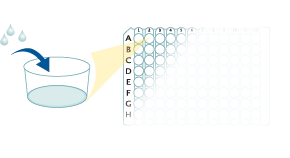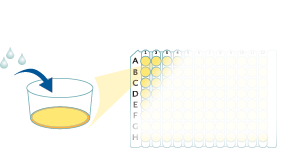Human Tie-2 Quantikine ELISA Kit Summary
Product Summary
Precision
Cell Culture Supernates, Serum, EDTA Plasma, Heparin Plasma
| Intra-Assay Precision | Inter-Assay Precision | |||||
|---|---|---|---|---|---|---|
| Sample | 1 | 2 | 3 | 1 | 2 | 3 |
| n | 20 | 20 | 20 | 40 | 40 | 40 |
| Mean (ng/mL) | 0.76 | 2.57 | 5.14 | 0.82 | 2.65 | 5.15 |
| Standard Deviation | 0.04 | 0.11 | 0.26 | 0.07 | 0.17 | 0.27 |
| CV% | 5.3 | 4.3 | 5.1 | 8.5 | 6.4 | 5.2 |
Recovery
The recovery of Tie-2 spiked to levels throughout the range of the assay was evaluated.
| Sample Type | Average % Recovery | Range % |
|---|---|---|
| Cell Culture Media (n=4) | 91 | 85-101 |
Linearity
Scientific Data
Product Datasheets
Preparation and Storage
Background: Tie-2
Tie-2, also known as Tek, is a transmembrane receptor tyrosine kinase (RTK) that functions as a receptor for Angiopoietin family proteins. It is expressed by embryonic and adult endothelial cells, hematopoietic stem cells, and a circulating population of proangiogenic monocytes. Tie-2 signaling is activated by Angiopoietins-1 and -4, while it can be either activated or inhibited by Angiopoietins-2 and -3. Tie-2 plays an important role in maintaining vascular integrity by mediating endothelial cell-smooth muscle cell communication and inhibiting endothelial cell apoptosis. It is also required for embryonic development of the endocardium. In addition, Tie-2 signaling mediates the quiescence of bone marrow stem cells in response to osteoblast-produced Angiopoietin-1. This quiescence is critical for maintaining an ongoing hematopoietic capability in the bone marrow.
Assay Procedure
Refer to the product- Prepare all reagents, standard dilutions, and samples as directed in the product insert.
- Remove excess microplate strips from the plate frame, return them to the foil pouch containing the desiccant pack, and reseal.
- Add 100 µL of Assay Diluent to each well.
- Add 100 µL of Standard, control, or sample to each well. Cover with a plate sealer, and incubate at room temperature for 2 hours.
- Aspirate each well and wash, repeating the process 3 times for a total of 4 washes.
- Add 200 µL of Conjugate to each well. Cover with a new plate sealer, and incubate at room temperature for 2 hours.
- Aspirate and wash 4 times.
- Add 200 µL Substrate Solution to each well. Incubate at room temperature for 30 minutes. PROTECT FROM LIGHT.
- Add 50 µL of Stop Solution to each well. Read at 450 nm within 30 minutes. Set wavelength correction to 540 nm or 570 nm.





Citations for Human Tie-2 Quantikine ELISA Kit
R&D Systems personnel manually curate a database that contains references using R&D Systems products. The data collected includes not only links to publications in PubMed, but also provides information about sample types, species, and experimental conditions.
27
Citations: Showing 1 - 10
Filter your results:
Filter by:
-
Fluid bolus increases plasma hyaluronan concentration compared to follow-up strategy without a bolus in oliguric intensive care unit patients
Authors: Serlo, M;Inkinen, N;Lakkisto, P;Valkonen, M;Pulkkinen, A;Selander, T;Pettilä, V;Vaara, ST;
Scientific reports
Species: Human
Sample Types: Plasma
-
Circulating Soluble EPCR Levels Are Reduced in Patients with Ischemic Peripheral Artery Disease and Associated with Markers of Endothelial and Vascular Function
Authors: Krug, J;Bochenek, ML;Gogiraju, R;Laubert-Reh, D;Lackner, KJ;Münzel, T;Wild, PS;Espinola-Klein, C;Schäfer, K;
Biomedicines
Species: Human
Sample Types: Plasma
-
Serum angiopoietin-1 concentration does not distinguish patients with ischaemic stroke from those presenting to hospital with ischaemic stroke mimics
Authors: JV Moxon, AK Kraeuter, J Phie, S Juliano, G Anderson, G Standley, C Sealey, RP White, J Golledge
BMC cardiovascular disorders, 2022-11-04;22(1):462.
-
Cholecalciferol supplementation and angiogenic markers in chronic kidney disease
Authors: J Kaur, K Kamboj, AK Yadav, P Kaur, V Kumar, V Jha
PLoS ONE, 2022-06-03;17(6):e0268946.
Species: Human
Sample Types: Serum
-
Microcirculatory perfusion disturbances following cardiac surgery with cardiopulmonary bypass are associated with in vitro endothelial hyperpermeability and increased angiopoietin-2 levels
Authors: NAM Dekker, ALI van Leeuwe, WWJ van Strien, J Majolée, R Szulcek, ABA Vonk, PL Hordijk, C Boer, CE van den Br
Crit Care, 2019-04-11;23(1):117.
Species: Human
Sample Types: Plasma
-
Different patterns of inflammatory and angiogenic factors are associated with peritoneal small solute transport and peritoneal protein clearance in peritoneal dialysis patients
Authors: Y Shi, H Yan, J Yuan, H Zhang, J Huang, Z Ni, J Qian, W Fang
BMC Nephrol, 2018-05-23;19(1):119.
Species: Human
Sample Types: Serum
-
Tie2 as a novel key factor of microangiopathy in systemic sclerosis
Authors: F Moritz, J Schniering, JHW Distler, RE Gay, S Gay, O Distler, B Maurer
Arthritis Res. Ther., 2017-05-25;19(1):105.
Species: Human
Sample Types: Serum
-
Angiopoietin-2 and soluble Tie-2 receptor plasma levels in children with obstructive sleep apnea and obesity
Authors: D Gozal, A Khalyfa, Z Qiao, DL Smith, MF Philby, D Koren, L Kheirandis
Obesity (Silver Spring), 2017-05-05;0(0):.
Species: Human
Sample Types: Plasma
-
TIE2-mediated tyrosine phosphorylation of H4 regulates DNA damage response by recruiting ABL1
Sci Adv, 2016-04-01;2(4):e1501290.
Species: Human
Sample Types: Cell Lysates
-
Angiopoietin/Tie2 Dysbalance Is Associated with Acute Kidney Injury after Cardiac Surgery Assisted by Cardiopulmonary Bypass.
Authors: Jongman R, van Klarenbosch J, Molema G, Zijlstra J, de Vries A, van Meurs M
PLoS ONE, 2015-08-26;10(8):e0136205.
Species: Human
Sample Types: Plasma
-
Clinical outcome, proteome kinetics and angiogenic factors in serum after thermoablation of colorectal liver metastases.
Authors: Wertenbroek, Marieke, Schepers, Marianne, Kamminga-Rasker, Hannetta, Bottema, Jan T, Muller Kobold, Anneke C, Roelofsen, Han, de Jong, Koert P
BMC Cancer, 2013-05-30;13(1):266.
Species: Human
Sample Types: Serum
-
Circulating angiopoietin-2 and soluble Tie-2 in type 2 diabetes mellitus: a cross-sectional study.
Authors: Rasul S, Reiter MH, Ilhan A, Lampichler K, Wagner L, Kautzky-Willer A
Cardiovasc Diabetol, 2011-06-23;10(0):55.
Species: Human
Sample Types: Plasma
-
Shedding of the endothelial receptor tyrosine kinase Tie2 correlates with leukemic blast burden and outcome after allogeneic hematopoietic stem cell transplantation for AML.
Authors: Koenecke C, Kumpers P, Lukasz A, Dammann E, Verhagen W, Gohring G, Buchholz S, Krauter J, Eder M, Schlegelberger B, Ganser A
Ann. Hematol., 2010-05-01;89(5):459-67.
Species: Human
Sample Types: Serum
-
Defective angiogenesis in hypoplastic human fetal lungs correlates with nitric oxide synthase deficiency that occurs despite enhanced angiopoietin-2 and VEGF.
Authors: Boucherat O, Franco-Montoya ML, Delacourt C, Martinovic J, Masse V, Elie C, Thebaud B, Benachi A, Bourbon JR
Am. J. Physiol. Lung Cell Mol. Physiol., 2010-03-26;298(6):L849-56.
Species: Human
Sample Types: Tissue Homogenates
-
Changes in vascular endothelial growth factor, angiopoietins, and Tie-2 levels with G-CSF stimulation in healthy donors.
Authors: Serefhanoglu S, Goker H, Buyukasik Y, Turgut M, Sayinalp N, Haznedaroglu IC, Aksu S, Akman U, Ozcebe OI
Ann. Hematol., 2008-12-11;88(7):667-71.
Species: Human
Sample Types: Plasma
-
The angiopoietin/Tie-2 system regulates pericyte survival and recruitment in diabetic retinopathy.
Authors: Cai J, Kehoe O, Smith GM, Hykin P, Boulton ME
Invest. Ophthalmol. Vis. Sci., 2008-05-01;49(5):2163-71.
Species: Bovine
Sample Types: Cell Lysates
-
Marrow angiogenesis-associated factors as prognostic biomarkers in patients with acute myelogenous leukaemia.
Authors: Lee CY, Tien HF, Hu CY, Chou WC, Lin LI
Br. J. Cancer, 2007-09-11;97(7):877-82.
Species: Human
Sample Types: Plasma
-
Angiopoietin 1 (Ang-1), angiopoietin 2 (Ang-2) and Tie-2 (a receptor tyrosine kinase) concentrations in peripheral blood of patients with thyroid cancers.
Authors: Niedzwiecki S, Stepien T, Kopec K, Kuzdak K, Komorowski J, Krupinski R, Stepien H
Cytokine, 2007-03-19;36(5):291-5.
Species: Human
Sample Types: Serum
-
Significant decrease in angiopoietin-1 and angiopoietin-2 after radical prostatectomy in prostate cancer patients.
Authors: Caine GJ, Ryan P, Lip GY, Blann AD
Cancer Lett., 2007-01-19;251(2):296-301.
Species: Human
Sample Types: Plasma
-
Differential levels of soluble angiopoietin-2 and Tie-2 in patients with haematological malignancies.
Authors: Quartarone E, Alonci A, Allegra A, Bellomo G, Calabro L, D'Angelo A, Del Fabro V, Grasso A, Cincotta M, Musolino C
Eur. J. Haematol., 2006-09-15;77(6):480-5.
Species: Human
Sample Types: Serum
-
Circulating levels of total angiopoietin-2 and the soluble Tie-2 receptor in women during ovarian stimulation and early gestation.
Authors: Molskness TA, Stouffer RL, Burry KA, Gorrill MJ, Lee DM, Patton PE
Fertil. Steril., 2006-09-14;86(5):1531-3.
-
Changes in plasma vascular endothelial growth factor, angiopoietins, and their receptors following surgery for breast cancer.
Authors: Caine GJ, Stonelake PS, Lip GY, Blann AD
Cancer Lett., 2006-08-07;248(1):131-6.
Species: Human
Sample Types: Plasma
-
Differential expression of angiopoietin-1, angiopoietin-2, and Tie receptors in placentas from pregnancies complicated by placenta accreta.
Authors: Tseng JJ, Hsu SL, Ho ES, Hsieh YT, Wen MC, Chou MM
Am. J. Obstet. Gynecol., 2006-02-01;194(2):564-71.
Species: Human
Sample Types: Tissue Homogenates
-
Potential role of soluble angiopoietin-2 and Tie-2 in patients with inflammatory bowel disease.
Authors: Koutroubakis IE, Xidakis C, Karmiris K, Sfiridaki A, Kandidaki E, Kouroumalis EA
Eur. J. Clin. Invest., 2006-02-01;36(2):127-32.
Species: Human
Sample Types: Serum
-
Multiple roles for the receptor tyrosine kinase axl in tumor formation.
Authors: Holland SJ, Powell MJ, Franci C, Chan EW, Friera AM, Atchison RE, McLaughlin J, Swift SE, Pali ES, Yam G, Wong S, Lasaga J, Shen MR, Yu S, Xu W, Hitoshi Y, Bogenberger J, Nör JE, Payan DG, Lorens JB
Cancer Res., 2005-10-15;65(20):9294-303.
Species: Human
Sample Types: Cell Lysates
-
Phase I clinical and pharmacokinetic study of PTK/ZK, a multiple VEGF receptor inhibitor, in patients with liver metastases from solid tumours.
Authors: Mross K, Drevs J, Muller M, Medinger M, Marme D, Hennig J, Morgan B, Lebwohl D, Masson E, Ho YY, Gunther C, Laurent D, Unger C
Eur. J. Cancer, 2005-06-01;41(9):1291-9.
Species: Human
Sample Types: Serum
-
Bi-directional cell contact-dependent regulation of gene expression between endothelial cells and osteoblasts in a three-dimensional spheroidal coculture model.
Authors: Stahl A, Wenger A, Weber H, Stark GB, Augustin HG, Finkenzeller G
Biochem. Biophys. Res. Commun., 2004-09-17;322(2):684-92.
Species: Human
Sample Types: Cell Culture Supernates
FAQs
No product specific FAQs exist for this product, however you may
View all ELISA FAQsReviews for Human Tie-2 Quantikine ELISA Kit
There are currently no reviews for this product. Be the first to review Human Tie-2 Quantikine ELISA Kit and earn rewards!
Have you used Human Tie-2 Quantikine ELISA Kit?
Submit a review and receive an Amazon gift card.
$25/€18/£15/$25CAN/¥75 Yuan/¥2500 Yen for a review with an image
$10/€7/£6/$10 CAD/¥70 Yuan/¥1110 Yen for a review without an image






